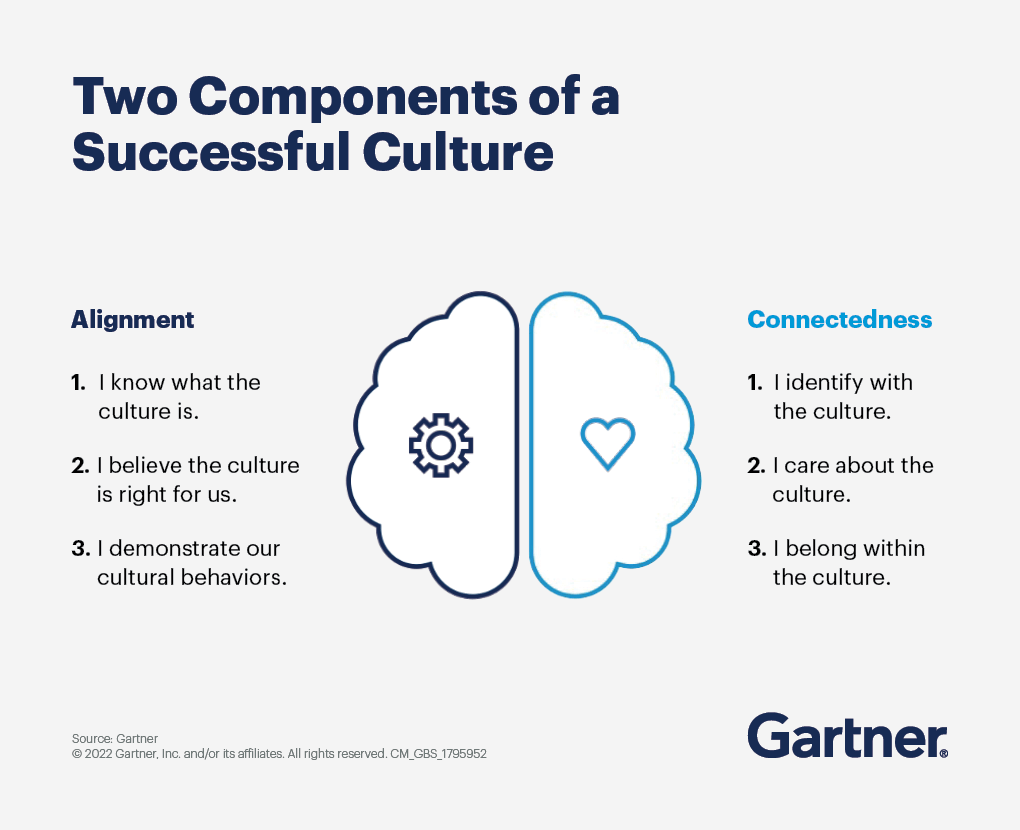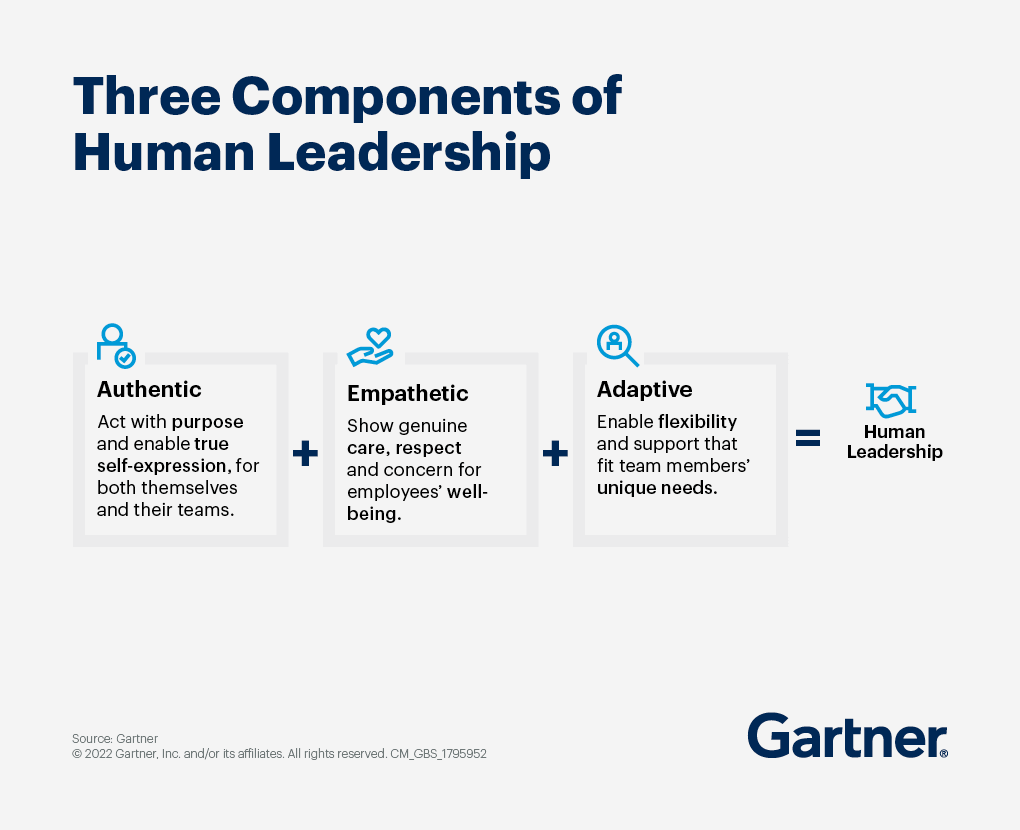As modern ways of working change how employees perceive and experience work, current culture and leadership strategies are no longer realistic. The best organizations are seeing hybrid work as an opportunity, not a disruption, and are uncovering new drivers within the new work environment to build cultural connectedness and develop human leaders. Use this 12-month roadmap to help your leadership team and chief human resources officer (CHRO):
- Gartner client? Log in for personalized search results.
Evolve Culture and Leadership for a Hybrid World
Make sure hybrid work doesn't dilute your culture and leadership.

Two Key Pillars of a Thriving Hybrid Workplace
The strategies leaders were once able to rely on to drive culture — the office space, in-person interactions, a singular set of behaviors and norms — are no longer effective. With 76% of employees saying that culture is important to be effective in their job, many leaders are concerned that culture will suffer or change in a virtual— first or hybrid world. You might be asking yourself: "If culture is how we do things around here, then what is it when there is no one ‘how’ and no one ‘here’ anymore?"
Consider this:
- Employees are having fewer in-person interactions: In the hybrid world, employees meet their teams in person only two days a week, compared to four days a week before the pandemic.
- Employees are spending less time in employer-controlled spaces: Employees spend 65% less time in offices today compared to before the pandemic.
- Employee ecosystems are shrinking: Employees are interacting once a week or less with their "weak ties" - colleagues that they do not work directly with compared to several times a week before the pandemic.
It’s time to uncover new drivers within hybrid work to make your culture thrive. A culture thrives when it meets two conditions: employees are aligned and connected to it.
- Alignment to a culture means that employees know what the culture is, believe in it and can demonstrate it.
- Connectedness to culture means that employees identify with the culture, care about it, and feel they belong in it.
While leaders have made progress in alignment, connectedness is currently in crisis: Only 1 in 4 employees are connected to organizational culture. With the absence of the environmental factors leaders relied on to drive connectedness — the office, physical proximity, and macro-based experiences — connectedness is at risk.
So how can leaders connect employees to culture today? Through work, emotional proximity and micro-based experiences. These three strategic approaches are highly impactful on connectedness, and connectedness itself has a significant impact on performance and retention.

Diffuse culture through work
Hybrid employees are spending more of their time working remotely and less time in offices. This is not necessarily a bad thing for culture: Gartner research shows that when employees work from home, they have a more intimate and focused relationship with their work. Work replaces the office as the most consistent cultural experience; regardless of location, work stays the same. As such, leaders must look to use work as a vessel for culture, and diffuse culture through work. Here’s how:
- Make employees aware of the value their role brings to the organization and the extent to which that value is (or is not) tied to a location.
- Equip employees to self-discover the personal value they gain from their work, and empower them to shape their employee experience around this value.
- Ensure the cultural experience is felt in day-to-day work by auditing work processes against the values and belief systems of your culture.
Connect through emotional proximity
There are two types of proximity that are often conflated: physical and emotional. Physical proximity is “being seen” — being in the same physical space. Emotional proximity is “feeling seen” — when employees feel they are valued, important and have an impact on others. Emotional proximity drives greater connectedness than physical, but it is more likely to happen when there is physical proximity. In a hybrid environment, leaders must be more intentional about creating emotional proximity without relying solely on physical proximity — especially in more distributed teams where physical proximity may not be a guarantee for all team members. Here’s how:
- Create empathy, not just interest, for the mission of the organization within employees.
- Identify the moments that matter for employees in the cultural experience as the ones where employees are most likely to feel their own importance and value within the organization.
- Guide teams to identify which moments of emotional proximity are enhanced when they are shared in person.
Optimize micro-based experiences
Ecosystems are shrinking for employees, while relationships within those ecosystems are intensifying — weak ties are getting weaker and strong ties are getting stronger. Employees are spending more time with their direct team members and managers, and less time with peers outside their teams. This is not necessarily a bad thing, as Gartner research shows that culture connectedness is more likely to be influenced by strong ties. Leaders must optimize for this more micro-based experience in the hybrid world. Here’s how:
- In order for micro-cultures to thrive, adopt a minimalist approach to macro-culture to serve as a safety net to catch toxic behaviors at the micro-level.
- Equip teams to design collective flexibility within micro-cultures that balances team needs with individual preferences.
- Recognize and reward individualization of culture, not compliance, to validate there is no single way to live the culture.
Today’s leaders must confront new realities — social and political turbulence, work-life fusion, and hybrid work have added a new layer of complexity to their roles. Plus, the leader-employee dynamic has shifted — with employees now expecting leaders to act and manage in a more human way. Employees are more vocal about their needs for flexibility, influence and self-determination in the workplace. Employees now expect more authenticity, empathy, and flexibility from their leaders, and amid the tightest labor market in a generation, the room for error is slim. Currently, leaders are ill-equipped to cope: only 35% of HR leaders and 49% of employees agree that leaders in their organizations have the capabilities they need to succeed in the future.
Organizations must equip their leaders to operate in a more human way — not only for employees, but for the business. Employees of human leaders are less likely to quit, more engaged, have better well-being, and perform at a higher level. Unfortunately, human leaders are few and far between. So, what needs to change? How can organizations create more human leaders? By understanding that leaders are humans, too — addressing the emotional barriers that prevent them from delivering. There are three main types of leaders who are ineffective at human leadership — doubtful achievers, fearful believers and uncertain strivers.

Garner commitment from doubtful achievers
Doubtful achievers are leaders who doubt that human leadership is important to achieving their business objectives. These leaders feel their job to help the business grow and to avoid emotions in the workplace. So how can we get leaders to commit to a new style of leadership?
Most HR executives are trying to convince leaders that they need to operate in a more human way by building a compelling, data-driven HR business case. But doubtful achievers weigh that against their own experiences — and often entrenched beliefs. Instead, HR must leverage trusted sources — peers and employees themselves — to inspire doubtful achievers to change.
Cultivate courage for fearful believers
Fearful believers are leaders who fear the vulnerability and risk associated with human leadership. They feel things getting more personal, and are worried about unknowingly crossing a line. So how can we give leaders the courage to navigate difficult situations?
Most HR executives are investing heavily in coaching and training to eliminate fear entirely. However — particularly in today’s environment — we’ve realized that fear is inevitable.
Instead, help leaders understand that fear can actually be healthy, if it is managed. The best organizations are building programs aimed at exhibiting positive behaviors despite fear, not eliminating it.
Instill confidence in uncertain strivers
Uncertain strivers are leaders who feel uncertain about how to effectively deliver human leadership. They question how to give their team the experience they want, especially when employees have differing expectations, wants and needs. So how can we equip leaders to confidently act?
Most HR executives are creating prescriptive guidance to help these leaders navigate employee interactions. However, given today’s increasingly variable employee needs and preferences, there are so many ways leaders can respond to a situation that they can end up overwhelmed. Instead, support leaders’ judgment by reducing the scope and ambiguity in these situations and help them act
Ultimately, to create more, we need to address the human emotions of our leaders — and when we do, we can almost double the number of human leaders in our organizations.


